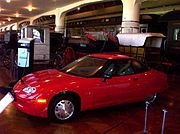
Electric motor

Main articles: Traction motor and Energy efficiency
The power of a vehicle electric motor, as in other vehicles, is measured in kW. 100 kW is roughly equivalent to 134 horsepower, although most electric motors deliver full torque over a wide RPM range, so the performance is not equivalent, and far exceeds a 134 horsepower fuel powered motor, which has a limited torque curve.[citation needed]
[edit] Large-scale electric transport: energy and motors
A trolleybus uses two overhead wires to provide electrical current supply and return to the power source
A trolleybus uses two overhead wires to provide electrical current supply and return to the power source
Most large electric transport systems are powered by stationary sources of electricity that are directly connected to the vehicles through wires. Due to the extra infrastructure and difficulty in handling arbitrary travel, most directly connected vehicles are owned publicly or by large companies. These forms of transportation are covered in more detail in metros, trams, electric locomotives, and trolleybuses.
In the systems above motion is provided by a rotary electric motor. However, it is possible to "unroll" the motor to drive directly against a special matched track. These linear motors are used in maglev trains which float above the rails supported by magnetic levitation. This allows for almost no rolling resistance of the vehicle and no mechanical wear and tear of the train or track. Levitation and forward motion are two independent effects; the forward motive force normally requires external power, although some types, such as Inductrack, achieve levitation at low speeds without any. In addition to the high-performance control systems needed, switching and curving of the tracks becomes difficult with linear motors, which to date has restricted their operations to high-speed point to point services.
[edit] Small scale electric vehicles
50+ mph fun-ev electric scooter
50+ mph fun-ev electric scooter
Some bicycles have been converted to electric power with a small battery and a small electric motor, some even have solar panels that are folded out when the vehicle is at rest. Small scale electric vehicles include electric cars, light trucks, neighborhood electric vehicles, motorcycles, motorized bicycles, electric scooters , golf carts, milk floats, forklifts and similar vehicles.
[edit] Issues regarding electric vehicles
[edit] Renewable electricity
Main article: Renewable electricity
Although electric vehicles have few direct emissions, all rely on energy created through electricity generation which will emit pollution and generate waste, unless it is generated by renewable source power plants. Even with power plants emitting CO2, the overall levels would be reduced because the entire process of moving a car is more efficient using electricity than producing gasoline and burning it in a car's engine.[5] Since electric vehicles use whatever electricity is delivered by their electrical utility/grid operator, it is effortless to make vast amounts of electric vehicles more efficient or reduce/eliminate pollution by modify their generation stations that are the electrical source for them. This would be done by an electrical utility or by the government under an energy policy.
Fossil fuel vehicle efficiency and pollution standards take years or decades to take effect over a majority nation's vehicle fleet, since those new efficiency and pollution standards can propagate through retirement, scrapping, and totalling of vehicles already on the road. To upgrade or change the energy source of all only-fossil fuel vehicles already on the road or apply new pollution or efficiency standards to them at once, would be impossible in most societies, because of unaffordability by the vehicles' owners or upgrade costs exceed vehicle costs, owner possessiveness and social upheaval. In democracies, the populace and/or elected officials would terminate such a plan, in non-democratic nations, a military response would be required to enforce such upgrade regulations leading to instability which could result in a loss of power against the current regime. In nations with fixed cutoffs of retirement of old vehicles such as Japan or Singapore a mandatory upgrade of all vehicles already on the road, or in nations without a lower or middle class owning vehicles or the nations where such would be illegal (which leaves only large business and/or government and/or the upper class owning fossil fuel vehicles), would be more feasible to mass upgrades of fossil fuel vehicles already on the road.
Naturally, electric vehicles will take advantage of whatever environmental gains happen when a renewable energy generation station comes online, a fossil fuel station is decommissioned or upgraded. There is a con to this, if a government or economic conditions or an electrical utility decides to run a region's electrical grid off more polluting fossil fuels, or more inefficiently, the reverse can happen. Even in such a situation, electrical vehicles are still more efficient than a comparable amount of fossil fuel vehicles. In areas with a deregulated electrical energy market, an electrical vehicle owner can choose whether to run his electrical vehicle off conventional electrical energy sources, or strictly from renewable electrical energy sources (presumably at an additional cost), and switch at any time between the two.
If a large proportion of private vehicles were to convert to grid electricity, the existing power plant and transmission infrastructure would be nearly sufficient, assuming most charging occurred overnight using the most efficient off-peak base load sources. [5] But there would be a significant need for additional resources (and emissions) in generation. However, the overall energy consumption would diminish because of the higher efficiency of electric vehicles over the entire cycle.
Electromagnetic radiation from high performance electrical motors has been claimed to be associated with some human ailments, but such claims are largely unsubstantiated except for extremely high exposures.[6] Electric motors can be shielded within a metallic Faraday's cage, but this adds weight to the vehicle and it is not conclusive that all electromagnetic radiation can be contained.








